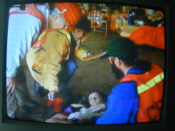 |
Shoring Practice Session for Southwest Portland NET's Sunday, April 18, 2004 starting at 1 pm
|
 |
 |
Shoring Practice Session for Southwest Portland NET's Sunday, April 18, 2004 starting at 1 pm
|
 |
 |
12' 5-1/2" long Volume = 35.6 ft3 Sp gr = 2.4 - 2.9 (Army TM 5-742) This calculates to a weight of 5320 lb - 6430 lb. |
|

Slip it under . . . |
 . . . carefully!
. . . carefully! |
|

Log-cabin cribbing and log-cabin fulcrum. |

|
|

|

|
 |
The concrete Jersey barrier is here starting to be lowered.
Four crowbars on this end are manned by four NET people. (The
four crowbars must apply a lifting force of about 3000 lbs, 750 pounds
per bar. The mechanical advantage we see in the photo is about 7.2,
so the downward force--by hand--at the end of an individual bar is about
100 pounds. Note that an individual would need to apply about 400
pounds were he alone.)
The concrete has just been raised, the cribbing removed, and now the concrete is starting to move down. Part of the problem is the overhang (large red arrow) of the top 4X4 beyond the lower 4X4. The crowbar will soon press down on the lower 4X4 starting the collapse of the fulcrum. Note that, at first, the forces on the various log-cabin pieces are predominantly vertical, but as the crowbar is tilted upward, horizontal forces appear throughout the system. These horizontal forces require some minimal frictional forces if the fulcrum structure is not to fail. |

|

|
 A little understanding of elementary physics is very helpful when we design and use fulcrums. |